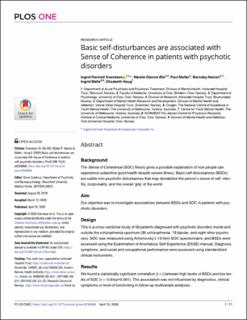| dc.contributor.author | Svendsen, Ingrid Hartveit | |
| dc.contributor.author | Øie, Merete Glenne | |
| dc.contributor.author | Møller, Paul | |
| dc.contributor.author | Nelson, Barnaby | |
| dc.contributor.author | Melle, Ingrid | |
| dc.contributor.author | Haug, Elisabeth | |
| dc.date.accessioned | 2020-09-30T13:47:14Z | |
| dc.date.available | 2020-09-30T13:47:14Z | |
| dc.date.created | 2020-04-16T13:20:15Z | |
| dc.date.issued | 2020 | |
| dc.identifier.citation | PLOS ONE. 2020, 15 (4), 1-11. | en_US |
| dc.identifier.issn | 1932-6203 | |
| dc.identifier.uri | https://hdl.handle.net/11250/2680593 | |
| dc.description.abstract | Background: The Sense of Coherence (SOC) theory gives a possible explanation of how people can experience subjective good health despite severe illness. Basic self-disturbances (BSDs) are subtle non-psychotic disturbances that may destabilize the person's sense of self, identity, corporeality, and the overall 'grip' of the world.
Aim: Our objective was to investigate associations between BSDs and SOC in patients with psychotic disorders.
Design: This is a cross-sectional study of 56 patients diagnosed with psychotic disorders inside and outside the schizophrenia spectrum (35 schizophrenia, 13 bipolar, and eight other psychoses). SOC was measured using Antonovsky's 13-item SOC questionnaire, and BSDs were assessed using the Examination of Anomalous Self-Experience (EASE) manual. Diagnosis, symptoms, and social and occupational performance were assessed using standardized clinical instruments.
Results: We found a statistically significant correlation (r = ) between high levels of BSDs and low levels of SOC (r = -0.64/p<0.001). This association was not influenced by diagnostics, clinical symptoms or level of functioning in follow-up multivariate analyses.
Conclusion: A statistically significant association between BSDs and SOC indicates that the presence and level of self-disturbances may influence the person's ability to experience life as comprehensive, manageable and meaningful. However, the cross-sectional nature of the study precludes conclusions regarding the direction of this association. | en_US |
| dc.description.sponsorship | This work was supported by Innlandet Hospital Trust, https://sykehuset-innlandet.no/ Grants No. 150281 (IS) and 150338 (IS), Eastern Norway Health Authority https://www.helse-sorost.no/, Grants no. 2006258 (IM, EH) – 2011085 (IM, EH)- 2014102 (IM, EH, IS), Research Council of Norway, https://www.forskningsradet.no/ Grant no. 223273 (IM) and an NHMRC Senior Research Fellowship, https://www.nhmrc.gov.au/ Grant no. 1137687 (BN). The funders had no role in study design, data collection and analysis, decision to publish, or preparation of the manuscript. | en_US |
| dc.language.iso | eng | en_US |
| dc.rights | Navngivelse 4.0 Internasjonal | * |
| dc.rights.uri | http://creativecommons.org/licenses/by/4.0/deed.no | * |
| dc.subject | Female | en_US |
| dc.subject | Humans | en_US |
| dc.subject | Male | en_US |
| dc.subject | Psychiatric Status Rating Scales | en_US |
| dc.subject | Psychometrics / methods | en_US |
| dc.subject | Psychotic Disorders / psychology* | en_US |
| dc.subject | Quality of Life / psychology | en_US |
| dc.subject | Schizophrenia / physiopathology | en_US |
| dc.subject | Sense of Coherence / physiology* | en_US |
| dc.subject | Surveys and Questionnaires | en_US |
| dc.subject | Adult | en_US |
| dc.subject | Cross-Sectional Studies | en_US |
| dc.title | Basic self-disturbances are associated with Sense of Coherence in patients with psychotic disorders | en_US |
| dc.type | Peer reviewed | en_US |
| dc.type | Journal article | en_US |
| dc.description.version | publishedVersion | en_US |
| dc.rights.holder | © 2020 Svendsen et al. This is an open access article distributed under the terms of the Creative Commons Attribution License, hich
permits unrestricted use, distribution, and reproduction in any medium, provided the original author and source are credited. | en_US |
| dc.source.pagenumber | 1-11 | en_US |
| dc.source.volume | 15 | en_US |
| dc.source.journal | PLOS ONE | en_US |
| dc.source.issue | 4 | en_US |
| dc.identifier.doi | 10.1371/journal.pone.0230956 | |
| dc.identifier.cristin | 1806617 | |
| cristin.ispublished | true | |
| cristin.fulltext | original | |
| cristin.qualitycode | 1 | |

